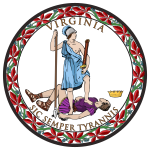| |||||||||||||||||
| |||||||||||||||||
 County and Independent City Results
ContentsParsons: 40-50% 50-60% | |||||||||||||||||
| |||||||||||||||||
| Elections in Virginia |
|---|
 |
The 1946 United States Senate election in Virginia was held on November 5, 1946. Incumbent Senator Harry F. Byrd was re-elected to a fourth term after defeating Republican Lester S. Parsons.
The first Virginia primary for United States Senate was held on August 6. Byrd defeated challenger Martin A. Hutchinson.

